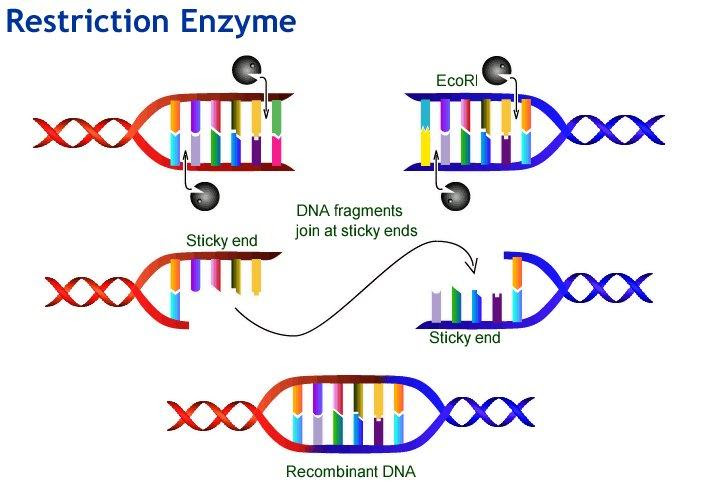
Why do most restriction enzymes cut at palindromic sequence?
Answer
387.9k+ views
Hint: In a double-stranded DNA or RNA molecule, a palindromic sequence is a type of nucleic acid sequence in which reading in a specific direction on one strand matches the reading in the opposite direction of the complementary strand.
Complete answer:
A restriction enzyme, also known as a restriction endonuclease or restrictase, is an enzyme that polymerizes DNA into pieces at or near restriction sites which are located inside the molecules. Restriction enzymes are a subset of the larger endonuclease enzyme family.
Restriction enzymes are essential tools in recombinant DNA technology because they can be extracted from bacterial cells and utilised in the lab to modify DNA fragments, such as those containing genes with the aid of genetic engineering technology. To defend itself against bacterial viruses known as bacteriophages, or phages, a bacterium uses a type of restriction enzyme. Restriction enzymes are classified into four categories: I, II, III, and IV, with differences in structure, cleavage site, specificity, and coagulation factors.
Image showing Restriction Enzyme action:

Restriction enzymes cut double-stranded DNA at specific sites based on the nucleotide pattern present there. As the palindromic sequence is recognised by the enzyme regardless of which side it approaches the DNA, hence a palindromic sequence enhances the likelihood of cutting both strands of DNA. Therefore, these restriction enzymes inevitably cut both strands at palindromic sequence since these sequences that they recognise are palindromic in nature, due to the fact that these sequences are short strings of equivalent bases on both DNA strands.
Note:
An enzyme is a protein that works as a stimulant or a catalyst in living organisms, by controlling the pace at which chemical reactions occur while the enzyme itself remains unaffected. All biological activities in living creatures involve chemical reactions, and the enzymes control the majority of them. Hydrolases, lyases, oxidoreductases, ligases, transferases, translocases and isomerases are the seven different types of enzymes. Among these different types of enzymes, the most abundant types of enzymes are oxidoreductases, transferases, and hydrolases.
Complete answer:
A restriction enzyme, also known as a restriction endonuclease or restrictase, is an enzyme that polymerizes DNA into pieces at or near restriction sites which are located inside the molecules. Restriction enzymes are a subset of the larger endonuclease enzyme family.
Restriction enzymes are essential tools in recombinant DNA technology because they can be extracted from bacterial cells and utilised in the lab to modify DNA fragments, such as those containing genes with the aid of genetic engineering technology. To defend itself against bacterial viruses known as bacteriophages, or phages, a bacterium uses a type of restriction enzyme. Restriction enzymes are classified into four categories: I, II, III, and IV, with differences in structure, cleavage site, specificity, and coagulation factors.
Image showing Restriction Enzyme action:

Restriction enzymes cut double-stranded DNA at specific sites based on the nucleotide pattern present there. As the palindromic sequence is recognised by the enzyme regardless of which side it approaches the DNA, hence a palindromic sequence enhances the likelihood of cutting both strands of DNA. Therefore, these restriction enzymes inevitably cut both strands at palindromic sequence since these sequences that they recognise are palindromic in nature, due to the fact that these sequences are short strings of equivalent bases on both DNA strands.
Note:
An enzyme is a protein that works as a stimulant or a catalyst in living organisms, by controlling the pace at which chemical reactions occur while the enzyme itself remains unaffected. All biological activities in living creatures involve chemical reactions, and the enzymes control the majority of them. Hydrolases, lyases, oxidoreductases, ligases, transferases, translocases and isomerases are the seven different types of enzymes. Among these different types of enzymes, the most abundant types of enzymes are oxidoreductases, transferases, and hydrolases.
Latest Vedantu courses for you
Grade 11 Science PCM | CBSE | SCHOOL | English
CBSE (2025-26)
School Full course for CBSE students
₹41,848 per year
Recently Updated Pages
Express the following as a fraction and simplify a class 7 maths CBSE

The length and width of a rectangle are in ratio of class 7 maths CBSE

The ratio of the income to the expenditure of a family class 7 maths CBSE

How do you write 025 million in scientific notatio class 7 maths CBSE

How do you convert 295 meters per second to kilometers class 7 maths CBSE

Write the following in Roman numerals 25819 class 7 maths CBSE

Trending doubts
Give 10 examples of unisexual and bisexual flowers

Draw a labelled sketch of the human eye class 12 physics CBSE

Differentiate between homogeneous and heterogeneous class 12 chemistry CBSE

Differentiate between insitu conservation and exsitu class 12 biology CBSE

What are the major means of transport Explain each class 12 social science CBSE

Franz thinks Will they make them sing in German even class 12 english CBSE




